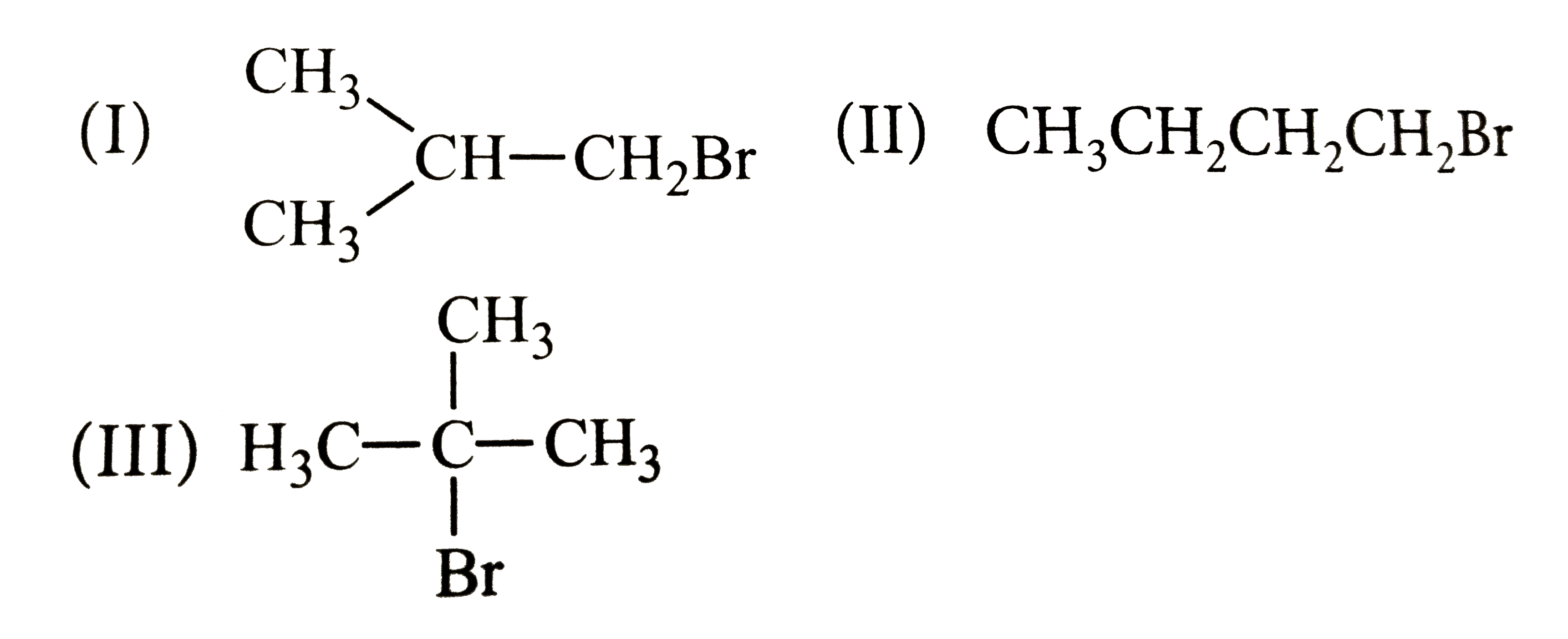Arrange the following compounds in decreasing order of their boiling points. (i) CH3Br
CH3CH2Br
CH3CH2CH2Br
CH3CH2CH2CH2Br
(i)>(ii)>(iii)>(iv)
(iv)>(iii)>(ii)>(i)
(i)gt(iii)gt(ii)gt(iv)
(iii)gt(iv)gt(i)gt(ii)
The correct Answer is:B
To arrange the compounds CH3Br, CH3CH2Br, CH3CH2CH2Br, and CH3CH2CH2CH2Br in decreasing order of their boiling points, we can follow these steps:
Step 1: Understand the factors affecting boiling points
Boiling points of organic compounds are influenced by several factors, including molecular weight (molar mass), intermolecular forces (such as dipole-dipole interactions and van der Waals forces), and the structure of the molecules. Generally, higher molar mass leads to higher boiling points due to increased van der Waals forces.
Step 2: Determine the molar mass of each compound
1. CH3Br:
- Molar mass = 12 (C) + 3(1) (H) + 80 (Br) = 12 + 3 + 80 = 95 g/mol
2. CH3CH2Br:
- Molar mass = 12(2) + 5(1) + 80 (Br) = 24 + 5 + 80 = 109 g/mol
3. CH3CH2CH2Br:
- Molar mass = 12(3) + 8(1) + 80 (Br) = 36 + 8 + 80 = 124 g/mol
4. CH3CH2CH2CH2Br:
- Molar mass = 12(4) + 10(1) + 80 (Br) = 48 + 10 + 80 = 138 g/mol
Step 3: Compare the molar masses
Now we can compare the molar masses:
- CH3Br: 95 g/mol
- CH3CH2Br: 109 g/mol
- CH3CH2CH2Br: 124 g/mol
- CH3CH2CH2CH2Br: 138 g/mol
Step 4: Arrange the compounds in order of boiling points
Since boiling points increase with increasing molar mass, we can arrange the compounds in decreasing order of their boiling points:
1. CH3CH2CH2CH2Br (highest molar mass, highest boiling point)
2. CH3CH2CH2Br
3. CH3CH2Br
4. CH3Br (lowest molar mass, lowest boiling point)
Final Answer
The order of the compounds in decreasing order of their boiling points is:
CH3CH2CH2CH2Br>CH3CH2CH2Br>CH3CH2Br>CH3Br
Boiling points of organic compounds are influenced by several factors, including molecular weight (molar mass), intermolecular forces (such as dipole-dipole interactions and van der Waals forces), and the structure of the molecules. Generally, higher molar mass leads to higher boiling points due to increased van der Waals forces.
1. CH3Br:
- Molar mass = 12 (C) + 3(1) (H) + 80 (Br) = 12 + 3 + 80 = 95 g/mol
2. CH3CH2Br:
- Molar mass = 12(2) + 5(1) + 80 (Br) = 24 + 5 + 80 = 109 g/mol
3. CH3CH2CH2Br:
- Molar mass = 12(3) + 8(1) + 80 (Br) = 36 + 8 + 80 = 124 g/mol
4. CH3CH2CH2CH2Br:
- Molar mass = 12(4) + 10(1) + 80 (Br) = 48 + 10 + 80 = 138 g/mol
Now we can compare the molar masses:
- CH3Br: 95 g/mol
- CH3CH2Br: 109 g/mol
- CH3CH2CH2Br: 124 g/mol
- CH3CH2CH2CH2Br: 138 g/mol
Since boiling points increase with increasing molar mass, we can arrange the compounds in decreasing order of their boiling points:
1. CH3CH2CH2CH2Br (highest molar mass, highest boiling point)
2. CH3CH2CH2Br
3. CH3CH2Br
4. CH3Br (lowest molar mass, lowest boiling point)
The order of the compounds in decreasing order of their boiling points is:
CH3CH2CH2CH2Br>CH3CH2CH2Br>CH3CH2Br>CH3Br
Topper's Solved these Questions
- BOOK - NCERT FINGERTPS ENGLISHCHAPTER - HALOALKANES AND HALOARENESEXERCISE - Chemical reactions68videos
HALOALKANES AND HALOARENES
- BOOK - NCERT FINGERTPS ENGLISHCHAPTER - HALOALKANES AND HALOARENESEXERCISE - Higher order thinking skills8videos
HALOALKANES AND HALOARENES
- BOOK - NCERT FINGERTPS ENGLISHCHAPTER - HALOALKANES AND HALOARENESEXERCISE - Methods of preparation13videos
HALOALKANES AND HALOARENES
- BOOK - NCERT FINGERTPS ENGLISHCHAPTER - GENERAL PRINCIPLES AND PROCESSES OF ISOLATION OF ELEMENTSEXERCISE - Assertion And Reason15videos
GENERAL PRINCIPLES AND PROCESSES OF ISOLATION OF ELEMENTS
- BOOK - NCERT FINGERTPS ENGLISHCHAPTER - POLYMERS EXERCISE - NCERT Exemplar9videos
POLYMERS
Similar Questions
Knowledge Check
- Question 1 - Select One
Arrange the following compounds in order of their reactivity towards SN2 reaction.
(i) CH3(CH2)3CH2Br
(ii) (CH3)2CHCH2CH2Br
(iii) CH3CH2−CH3∣CH−CH2Br
(iv) CH3−CH3∣C∣CH3−CH2BrA(i)gt(ii)gt(iii)gt(iv)B(ii)gt(iii)gt(iv)gt(i)C(iii)gt(i)gt(ii)gt(iv)D(iv)gt(ii)gt(i)gt(iii)
Arrange the following compounds in increasing order of their boiling points.

(ii)CH3CH2CH2CH2Br
H3C−CH3∣C∣Br−CH3View SolutionArrange the following compounds in increasing order of their boiling points.
 , (ii) CH3CH2CH2CH2Br
, (ii) CH3CH2CH2CH2Br
(iii) H3C−CH3C∣∣Br−CH3View SolutionArrange the following compounds in an increasing order of their acid strengths :
(CH3)2CHCOOH,CH3CH2CH(Br)COOH,CH3CH(Br)CH2COOHView SolutionArrange the following compounds in increasing order of their acid strengths:
(CH3)2CHCOOH,CH3CH2CH(Br)COOH,
CH3CH(Br)CH2COOHView SolutionArrange the following compounds in an increasing order of their acid strengths :
(CH3)2CHCOOH,CH3CH2CH(Br)COOH,CH3CH(Br)CH2COOHView SolutionArrange the following compounds in an increasing order of their acid strengths :
(CH3)2CHCOOH,CH3CH2CH(Br)COOH,CH3CH(Br)CH2COOHView SolutionArrange the following compounds in increasing order of SN1 reactivity.
CH3CH2Br,CH2=CHCH(Br)CH3,CH3CH(Br)CH3View Solution

